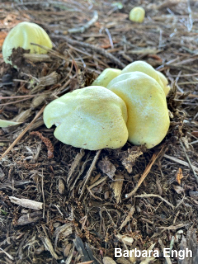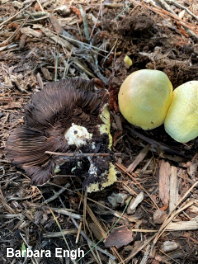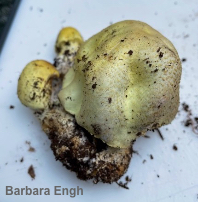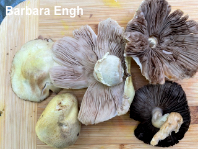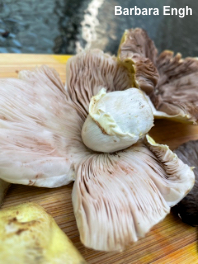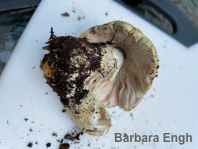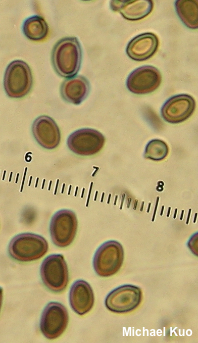| Major Groups > Gilled Mushrooms > Dark-Spored > Agaricus > Agaricus floridanus |

|
Agaricus floridanus [ Basidiomycota > Agaricales > Agaricaceae > Agaricus . . . ] by Michael Kuo Apparently not common, Agaricus floridanus is known from the eastern and southeastern United States, from Long Island to North Carolina and Florida. Distinctive features include the fairly large size of the mushrooms, the tendency to grow in clusters in mulch or in sandy areas, the yellow and fibrillose (and often lumpy-looking) cap, the color progression of the gills from pale to pinkish to brown, and the strong almondy odor. Agaricus floridanus is easily confused with other yellow—or yellowing—species, including Agaricus comptulus and Agaricus auricolor, which are much smaller mushrooms with caps only up to about 5 cm across, and yellowish versions of Agaricus fissuratus (née Agaricus arvensis), which does not grow in clusters, appears only in grass, is less "lumpy" when young, has gills that do not turn pinkish before turning brown, and features larger spores. Thanks to Barbara Engh for collecting, documenting, and preserving Agaricus floridanus for study; her collection is deposited in The Herbarium of Michael Kuo. Description: Ecology: Saprobic; growing gregariously in woodchips or compost in lawns and other urban areas; summer and fall; originally described from DeFuniak Springs, in the Florida panhandle; documented from Long Island to North Carolina and Florida. The illustrated and described collection is from North Carolina. Cap: 5–10 cm across; at convex and "lumpy" looking, with an inrolled margin, expanding to broadly convex; dry; appressed-fibrillose, with the fibrils breaking up into small scales; yellow when young, becoming grayish to whitish underneath fine yellow scales; yellowing when rubbed repeatedly. Gills: Free from the stem or nearly so; crowded; short-gills frequent; whitish in buttons, becoming pinkish, and then dark brown in maturity; covered with a white to yellowish partial veil when in the button stage. Stem: 4–8 cm long; 1.5–2.5 cm thick; equal; bald above the ring; ring thin and yellowish, hinging skirt-like; fibrillose and whitish to yellowish below the ring; not bruising, or bruising slightly yellow; basal mycelium white. Flesh: White; firm; unchanging when sliced, or becoming yellowish to orangish. Odor: Strong, of almonds. Dried Specimens: Dull orangish. Spore Print: Dark brown. Microscopic Features: Spores: 45–6 x 3.5–4.5 µm; ellipsoid, or occasionally subglobose; smooth; thick-walled; brown in KOH. Basidia 12–15 x 5–7 µm; clavate; 4-sterigmate. Pleurocystidia not found. Cheilocystidia not found. Pileipellis a cutis; elements 2.5–10 µm wide, smooth, hyaline to yellowish in KOH. REFERENCES: C. H. Peck, 1911. (Smith, 1940; Freeman, 1979a; Freeman, 1979b; Didukh et al., 2005 ["comtulus"]; Kerrigan, 2016.) Herb. Kuo 07032102. This site contains no information about the edibility or toxicity of mushrooms. |
© MushroomExpert.Com |
|
Cite this page as: Kuo, M. (2021, August). Agaricus floridanus. Retrieved from the MushroomExpert.Com Web site: http://www.mushroomexpert.com/agaricus_floridanus.html |
